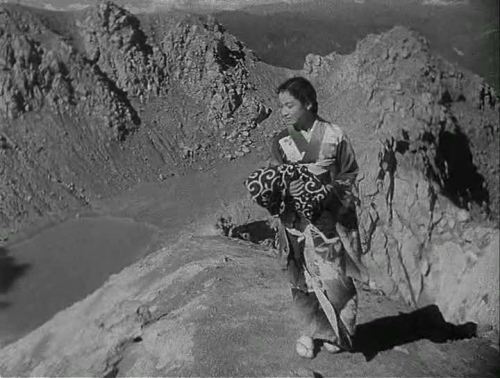There's just so much odd with Arnold Fanck's venture into Japanese cinema it's hard to know where to start, but that very strangeness yields insights into the way different cultures view each other Fanck's Daughter of the Samurai was made about a decade after his masterpieces like The Holy Mountain (1926) and The White Hell of Pitz Palu (1929) By this stage in his life, Fanck wasn't "free". He had to do what the Third Reich wanted, or else. Compared with Leni Riefenstahl's films, like The Triumph of the Will, Daughter of the Samurai is not a "Nazi" film as some suggest. On the contrary, it's film by a European who doesn't know much about Japanese culture, or Japanese cinema, but does know mountains.
Fanck created Bergfilm: poetic, esoteric movies filmed in the Alps, with actors and cameramen who did their own climbing, often in dangerous conditions, with little of the equipment climbers rely upon today. This sense of first person danger permeates the films. Fanck was a geologist who knew how mountains were formed and how powerful they were. In Bergfilms, mountains are the real stars, towering majestically over all else, including the actors, auteurs and cameraman. The mountains are highly symbolic, connecting to the intellectual challenges of the late Romantic period. To call them "German westerns" is hopelessly superficial.
Daughter of the Samurai was largely shot in the studio, though there are wonderful shots of Mount Fuji, of terraced rice fields and snow-covered peaks, showing that Fanck and his cinematographers still had an eye for the patterns of Nature. In this film, they also show shots of industrial processes and stylized dancers. They even respond to the rhythms of rice-planting : like mountain climbing , planting rice is repetitive and physically demanding, but worth doing for an ultimate reward.
The film was made in 1937, when Japan yet again invaded China. Germany and Japan became wartime allies since they had a common enemy: Russia. At the time neither was at war with the west. The Germans were happy to support Japan's invasion of China. Both countries wanted Lebensraum. In Daughter of the Samurai, a Japanese man who speaks German and a German woman who speaks Japanese meet on board ship. Teruo Yamato (whose name means "Japan") is played by Isamu Kosugi, a star and director in the Japanese film industry which was as sophisticated and active as anything in Europe. Therein lies some of the tension in the background. In theory the film was a joint Gertman/Japanese venture, but the Germans won. Daughter of the Samurai is totally Eurocentric. It is not racist, because the Japanese are treated with sympathy, but not as equals. There are good shots of Japanese progress, eg modern buildings, fast trains, neon lights etc, but like most foreigners the film-makers fall back on clichés like cherry blossom and lanterns. Swastika flag and the Rising Sun flags fly together for a brief moment but that's about as political as the film gets. Perhaps the Germans just didn't know how advanced the Japanese cinema industry really was, even then. The film isn't deliberately offensive, but it sustains colonialist ideas. No surprise that the Japanese weren't amused.
Setsuko Hara plays Mitsuko, Terou's dutiful wife. She too was a big star in Japan and, like Kosugi, international in the sense that she travelled a lot in the west. Teruo's father is played by Sessue Hayakawa, who emigrated to the US and made his name in American movies. Had he stayed in Hollywood during the war years, he would have been interned in the notorious camps for Nisei, where thousands perished. So it's ironic to see him in this film funded by the Nazi regime. That's him in the photo above with Ruth Eweier, the German blonde whom Mitsuko fears will take her husband away. Here's a good shot of the two women in a modern kitchen. A sophisticate like Hara probably had a western kitchen (she's still alive, aged 95) but you can understand the pointed cultural tension.
Being a daughter of samurai, Mitsuko decides to kill herself. Teruo, realizing what she's doing, jumps into his fancy car, driving on hairpin bends on a cliffside. The road collapses round a lake. He then swims the whole way across, and climbs a volcano, burning his feet. Amazingly, he meets Mitsuko at the summit though she left their house and walked all the way, dressed in a kimono. Nonetheless, we get to see good shots of cliffs and mountains - traces of Bergfilm, after all. Some scenes are quite spectacular. .The volcano erupts, destroying the Yamato farmhouse in the valley. Somehow, though, Teruo and Mitsuko survive. His feet are bandaged but she's in full Geisha regalia. Unlike Fanck's gutsy heroine Leni Riefenstahl, Hara must revert to being an unrealistic "Japanese wife". You can understand why the Japanese director and crew, highly experienced professionals, were annoyed.
Now, it's time to offend the Chinese. Teruo and Mitsuko move to Manchuria, where they farm with tractors, since they're modern, unlike the Chinese peasants whose land they have occupied. Daughter of the Samurai doesn't set out to annoy, any more than many other films of the time, like The Good Earth, made in Hollywood in the same year, and a big hit with non-Asian audiences. These films just represent the way whites looked upon non-whites, which was how things were then. As long as we see Daughter of the Samurai in context, it's OK.


No comments:
Post a Comment